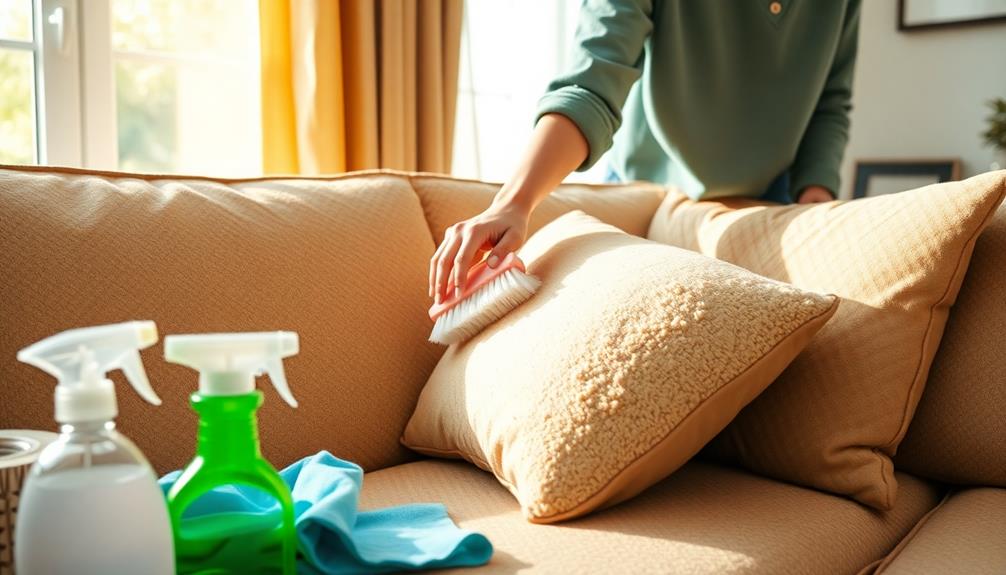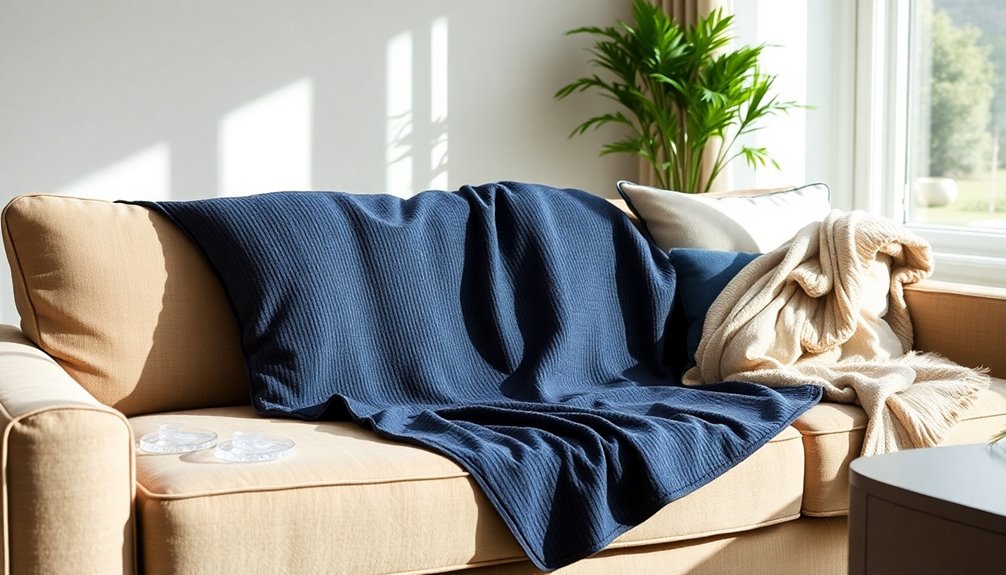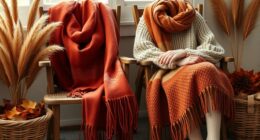To effectively clean furniture fabric, begin by referring to the upholstery code on the tag. Start by thoroughly vacuuming to eliminate dust and debris. If the fabric can withstand water, combine water, vinegar, and dish soap to form a cleaning solution. Use a damp microfiber cloth with this solution to blot out stains, but always conduct a spot test first! To get rid of odors, sprinkle baking soda on the fabric, let it sit, and then vacuum it off. It’s also essential to regularly plump and rotate cushions to ensure even wear. Following these steps will help you preserve the appearance and longevity of your furniture, and there’s still more to discover about specific cleaning methods.
Key Takeaways
- Check the upholstery care label for cleaning codes (W, S, WS, X) to determine safe cleaning methods.
- Vacuum fabric thoroughly with an upholstery attachment to remove dust and debris before cleaning.
- For water-safe fabrics (W), use a DIY cleaning solution of water, dish soap, and vinegar for spot cleaning.
- Perform a spot test on an inconspicuous area before applying any cleaning solution to avoid damage.
- Regularly maintain fabric by fluffing cushions, sprinkling baking soda to absorb odors, and vacuuming monthly.
Cleaning Tools and Supplies
Cleaning fabric furniture effectively requires the right tools and supplies. Start with a Dyson vacuum equipped with an upholstery attachment. This will help you regularly remove dust and crumbs, keeping your furniture looking fresh.
For deeper cleaning, the Bissell Little Green Machine is ideal for tackling tough stains, making your job easier. Additionally, it's beneficial to understand the importance of preventing cross-contact when cleaning, especially if children or pets are present, to guarantee a safe environment.
Don't forget to keep a lint roller handy. It's perfect for quickly picking up pet hair and dust from fabric surfaces without needing any power. A simple baking soda mix can also work wonders as a natural deodorizer, eliminating odors effectively. To use it, sprinkle some on the upholstery, let it sit for a while, and then vacuum it up.
For your DIY cleaning solutions, a spray bottle is essential. Fill it with a gentle cleaning mixture and keep your microfiber cloths nearby for blotting and wiping.
Finally, consider applying Scotchgard to absorbent fabrics like cotton and linen. This protective barrier helps resist stains and spills, but remember to reapply it periodically to maintain its effectiveness.
With these tools and supplies, you're well-equipped to keep your fabric furniture in top shape.
Understanding Upholstery Codes
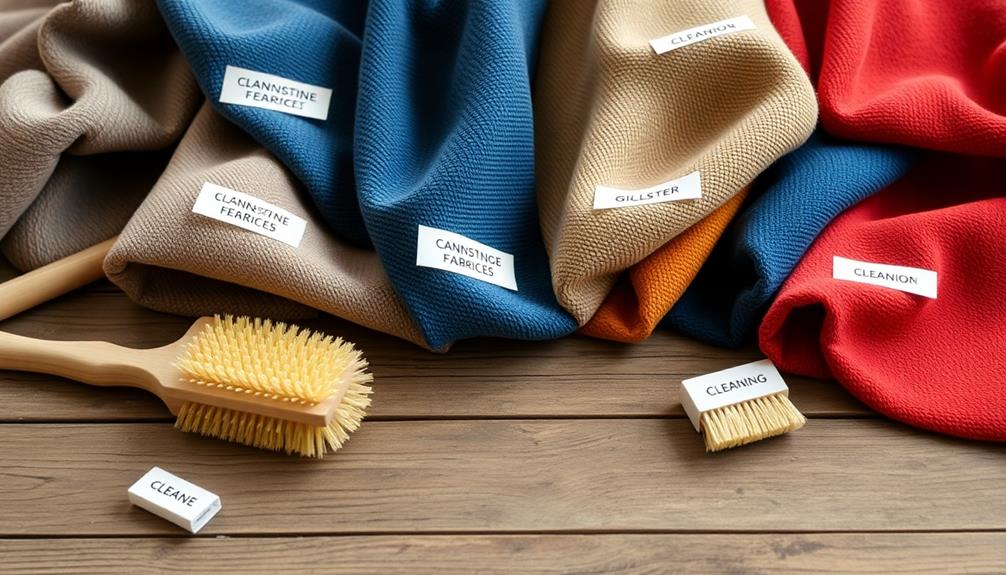
When cleaning your upholstered furniture, understanding the upholstery codes is essential. Each code tells you the best cleaning method to use, helping you avoid damage.
For example, using the wrong cleaning solution can lead to discoloration or deterioration of the fabric, similar to how certain foods can be toxic to pets, such as toxic foods for birds.
Don't forget to perform a spot test on a hidden area first to guarantee the cleaning solution works with your fabric.
Cleaning Code Definitions
Understanding upholstery cleaning codes is essential for maintaining your furniture's fabric, as these codes, typically found on care labels, guide you on the safest cleaning methods. Each code indicates specific approaches for upholstery cleaning, ensuring you don't damage the fabric surface.
Proper care of your furniture is vital, especially when considering the potential for common types of cold medications that may inadvertently come into contact with upholstery and create stains.
The "W" code means you can use water-based cleaners, making it easy to tackle stains with household products. If you see an "S," only solvent-based cleaners are acceptable, which often leads to professional cleaning services. The "WS" code is more flexible, allowing both cleaning methods, but it's important to perform a spot test before applying any solution to avoid adverse reactions.
Lastly, if your care label displays an "X," you'll need to stick to vacuuming or light brushing, as using water or solvents could harm the fabric.
Knowing these cleaning codes helps you choose the right products for furniture cleaning, preserving your upholstery in the long run. Always consult the care label for guidance, and remember that proper cleaning techniques will maintain the beauty and longevity of your furniture.
Importance of Spot Testing
Spot testing is a essential step in upholstery care, ensuring you protect your furniture from potential damage. Before using any cleaning solution, it's important to understand your upholstery codes. These codes indicate the appropriate cleaning methods for specific fabric types.
For example, if your fabric has a code "W," you can safely use water-based cleaning agents. Conversely, "S" means only solvent-based cleaners are suitable. If it's labeled "WS," you've got the flexibility to choose either method, but spot testing remains significant.
To prevent discoloration or damage that could void warranties, always test your chosen cleaning solution on an inconspicuous area first. Apply a small amount of the cleaning agent and let it sit briefly.
Check for any adverse reactions, such as fading or changes in texture, before proceeding to more visible sections of the fabric. Spot testing allows you to confidently select a cleaning method that won't harm your upholstery.
Preparing for Cleaning
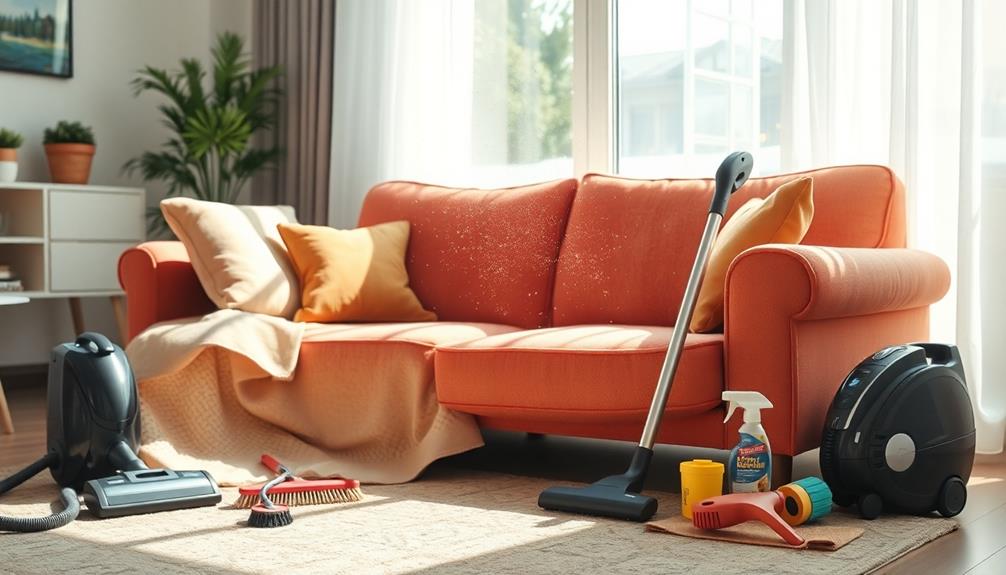
Before diving into the cleaning process, it's vital to prepare adequately to guarantee the best results. Start by reviewing the manufacturer's care instructions and cleaning codes on the furniture tag. This step helps you avoid damage and guarantees you use the right cleaning method.
Next, identify the fabric type to select the appropriate cleaning solutions. Common codes include W (water-based), S (solvent), WS (water or solvent), and X (vacuum only). Gather all necessary supplies, such as vacuum cleaners, microfiber cloths, and mild detergents, for efficiency.
Don't forget to conduct a spot test with any cleaning solution on a hidden area of the fabric. This checks for colorfastness and potential damage before applying it to visible areas. Finally, consider ventilation and environmental factors, like humidity and temperature, that can affect how cleaning solutions work on furniture fabrics.
| Step | Action |
|---|---|
| Review Care Instructions | Check the furniture tag for guidelines. |
| Identify Fabric Type | Determine the cleaning code needed. |
| Gather Supplies | Collect vacuum cleaners and detergents. |
Step-by-Step Cleaning Process
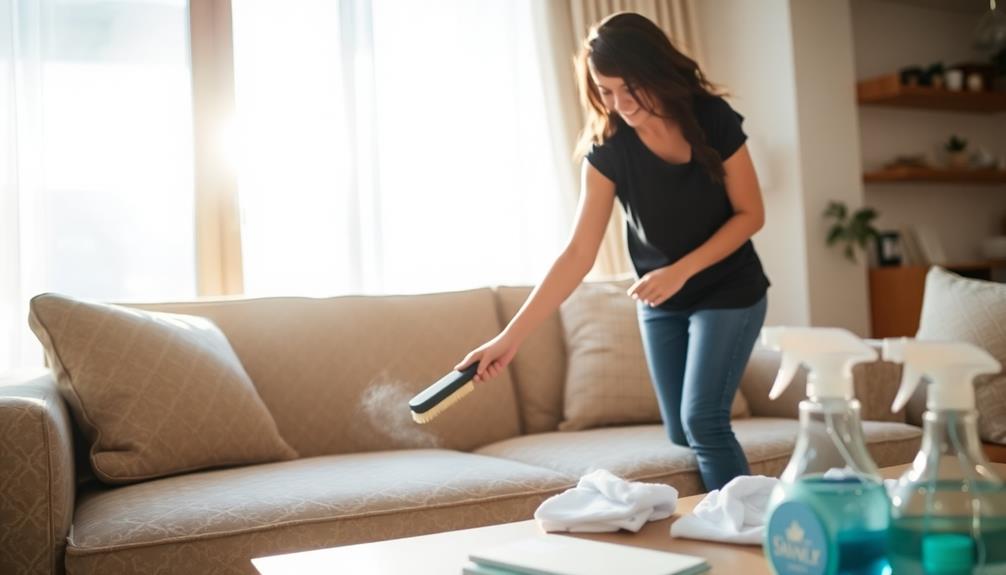
With your furniture properly prepared for cleaning, it's important to tackle the step-by-step process. First, check the manufacturer's cleaning code on the upholstery tag. This code will tell you the appropriate cleaning method (W, S, WS, or X) for your fabric.
Next, vacuum the furniture thoroughly using an upholstery attachment to remove dust, hair, and debris. Make sure to pay special attention to crevices and seams where dirt and pet hair tend to accumulate. If you have pets, a lint roller or a pet hair removal brush can be particularly effective in removing cat hair from furniture. For stubborn areas, consider using a rubber glove to gently lift embedded hairs from the fabric.
If your fabric is water-safe (W), create a cleaning solution using 2 cups of distilled water, 1 tablespoon of dish soap, and 1 tablespoon of vinegar. Dampen a microfiber cloth with this solution and gently blot the stains. Always remember to perform a spot test on an inconspicuous area to verify there's no color transfer or damage before treating the entire surface.
After you've cleaned your upholstered furniture, it's vital to allow the fabric to air dry completely. To speed up the drying process and avoid moisture accumulation, consider using a fan.
This step is important for maintaining the integrity of the fabric and guaranteeing a fresh, clean finish. Following these steps will help you effectively clean your furniture and keep it looking its best.
Techniques for Deodorizing
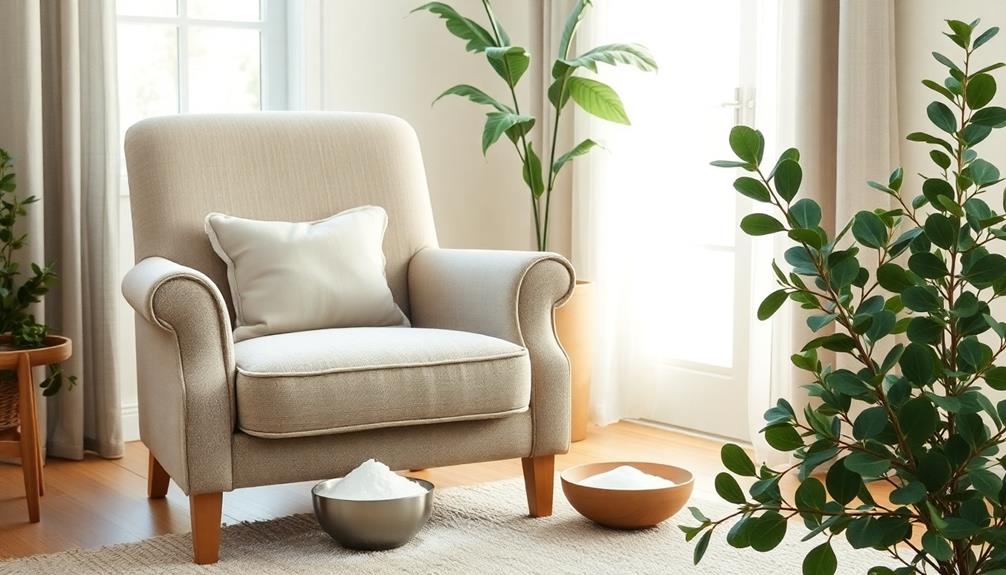
To keep your furniture smelling fresh, start by applying baking soda to absorb odors.
If that doesn't do the trick, a vinegar solution can neutralize persistent smells effectively.
Regular maintenance, like vacuuming, will help prevent odors from building up in the first place.
Baking Soda Application
When you're looking to freshen up your upholstered furniture, baking soda is a powerful ally. This natural and non-toxic deodorizer is perfect for maintaining a fresh scent and can help extend the life of your upholstery.
Here are a few effective cleaning tips for applying baking soda:
- Sprinkle generously: Cover the fabric surface with a good amount of baking soda, ensuring it reaches all areas.
- Let it sit: For best deodorizing effect, allow the baking soda to sit for 1-2 hours, or up to 24 hours for stronger odors. This will help absorb smells and loosen stains.
- Vacuum thoroughly: After the waiting period, use an upholstery attachment to vacuum up the baking soda, removing all residue and trapped odors.
Vinegar Odor Neutralizer
Vinegar serves as an effective natural deodorizer for upholstered furniture, breaking down odor-causing substances and leaving your fabric smelling fresh.
To neutralize odors in your upholstery, mix equal parts distilled white vinegar and water in a spray bottle. Lightly mist the fabric with this solution, ensuring you don't saturate it. This method allows the vinegar to penetrate the fabric and absorb unpleasant odors.
After applying the vinegar solution, let it sit on the fabric for about 15-30 minutes. This duration is essential, as it helps to effectively absorb and eliminate persistent odors.
Once the time is up, allow the fabric to air dry. After it's dry, vacuum the upholstery to remove any remaining particles, enhancing the freshness of the fabric.
For particularly strong odors, consider combining vinegar with baking soda. Start by applying baking soda to absorb the odors, then follow up with the vinegar solution for a deeper clean.
This two-step approach will give your upholstery an even fresher scent, ensuring your furniture remains inviting and pleasant.
Regular Maintenance Tips
Maintaining fresh-smelling upholstery doesn't have to be a chore; with regular maintenance, you can keep odors at bay.
By incorporating a few simple techniques into your cleaning schedule, you'll notice a significant difference in the freshness of your furniture.
- Vacuum regularly: Aim to vacuum your upholstered furniture at least once a month. This helps remove dust, pet hair, and allergens that can contribute to odors.
- Use baking soda: Sprinkle baking soda generously on the fabric surfaces, let it sit for 1-2 hours, then vacuum it off. This will absorb unwanted odors and leave your upholstery smelling fresher.
- Fluff and rotate cushions: Don't forget to fluff and rotate your cushions regularly. This prevents stagnant odors from building up in high-use areas.
For persistent odors, try a mixture of distilled white vinegar and water as a spray to neutralize smells.
Let it dry completely afterward for the best results.
Fluffing and Maintaining Cushions
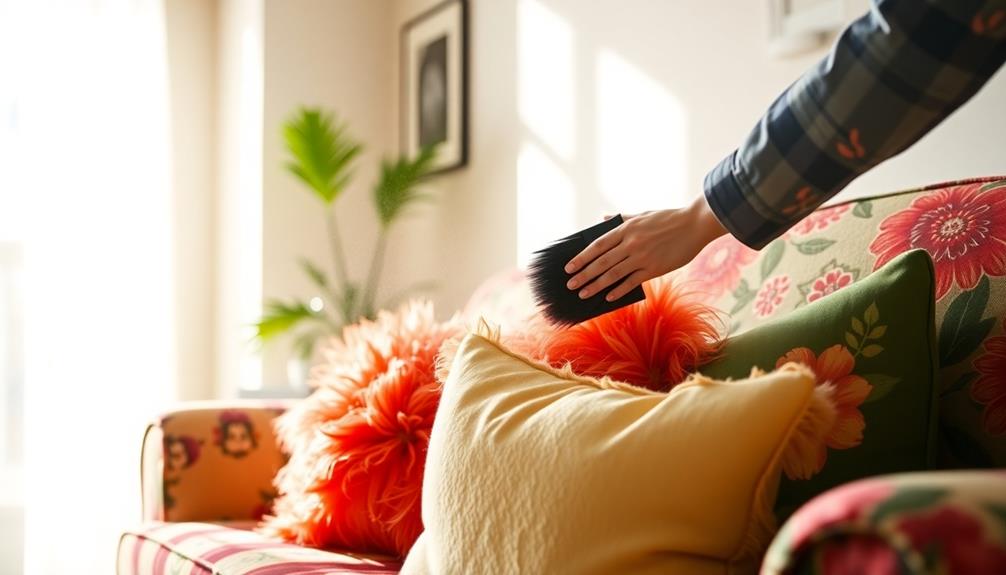
Cushion care is essential for preserving both the comfort and appearance of your furniture. To maintain your cushions, you should regularly fluff and rotate them every few weeks. This practice helps prevent lumps from forming due to frequent seating in the same spot.
Use the shake and spin method: remove the cushions, shake them to redistribute the filling, and spin them to enhance their fluffiness. Fluffed cushions not only improve the aesthetic of your upholstery but also provide better support and comfort for everyone using them.
If you notice any wear patterns, address them promptly by fluffing the affected cushions. This action guarantees even distribution of filling, which prolongs their lifespan.
Consistent maintenance of your cushions can greatly extend the overall life of your furniture. By taking these simple steps, you can keep your upholstery looking fresh and inviting.
Effective Stain Removal Methods
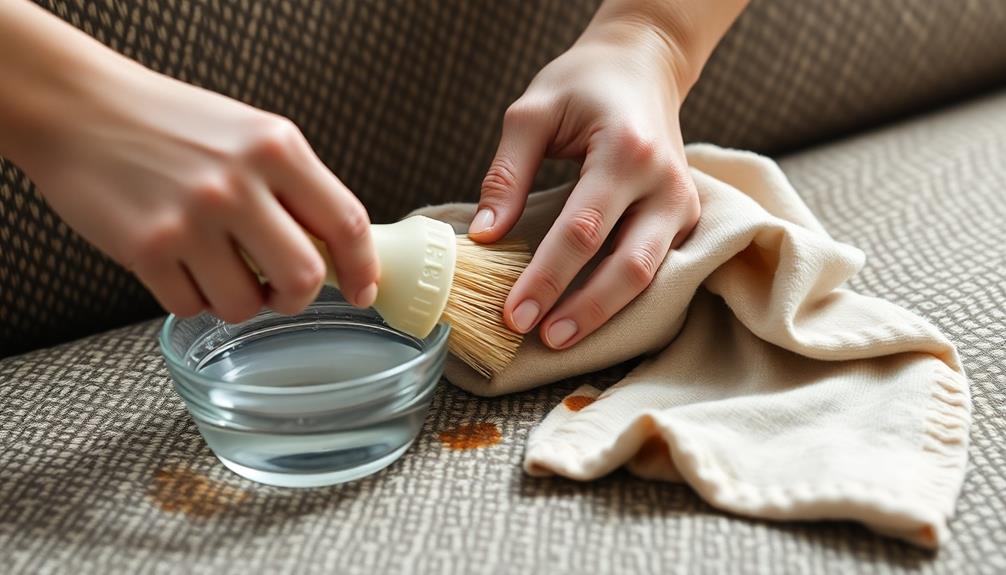
Stains can be a homeowner's nightmare, but knowing how to tackle them effectively can save your furniture from lasting damage.
When dealing with stains on your upholstery, it's essential to act quickly and choose the right method based on the type of stain. Here are some effective approaches:
- For water-based stains: Gently blot the area with a cloth dampened in a mixture of distilled water and white vinegar. This lifts the stain without damaging the fabric.
- For oil-based stains: Use a solvent-based cleaner, but always follow the manufacturer's guidelines and perform a spot test on an inconspicuous area first.
- For stubborn stains: Mix dish soap, vinegar, and water, apply it with a microfiber cloth, and let it sit for a few minutes before blotting it dry.
Additionally, always blot fresh spills immediately with a clean, dry cloth to absorb excess liquid.
Regular maintenance, like vacuuming and using fabric protectants, can help prevent stains from setting in the first place.
With these methods, you can keep your couch and sofa looking clean and fresh!
Recommended Cleaning Products
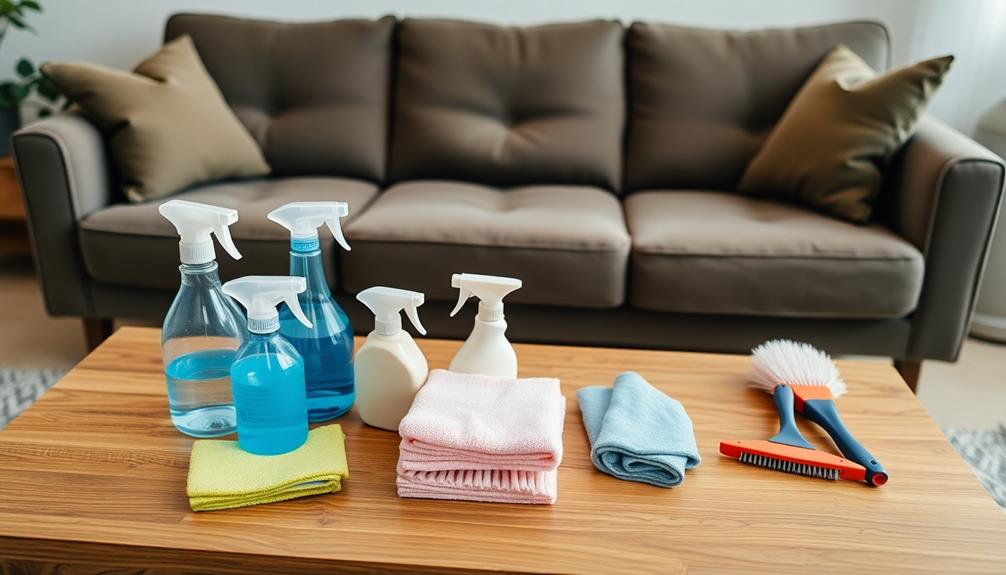
Choosing the right cleaning products can make all the difference in keeping your furniture fabric looking its best. Start by using a vacuum cleaner with an upholstery attachment to effectively remove dust, dirt, and pet hair from your couch cushions.
For deeper cleaning, consider OxiClean White Revive, which is safe for colorfast fabrics and great for brightening upholstery.
If you're looking for a DIY option, create a cleaning solution using clean water, clear Dawn dish soap, and distilled white vinegar. Make sure to do a spot test on a hidden area to confirm it won't damage your fabric.
For odors, sprinkle baking soda on your furniture fabric before vacuuming it up; it acts as a natural deodorizer.
Additionally, invest in a pet hair and lint remover brush, which is perfect for quickly picking up stray hairs without the hassle of power tools.
With these recommended cleaning products at your disposal, you'll keep your furniture looking fresh and inviting, guaranteeing it remains a beautiful part of your home for years to come.
Fabric Care Tips and Tricks
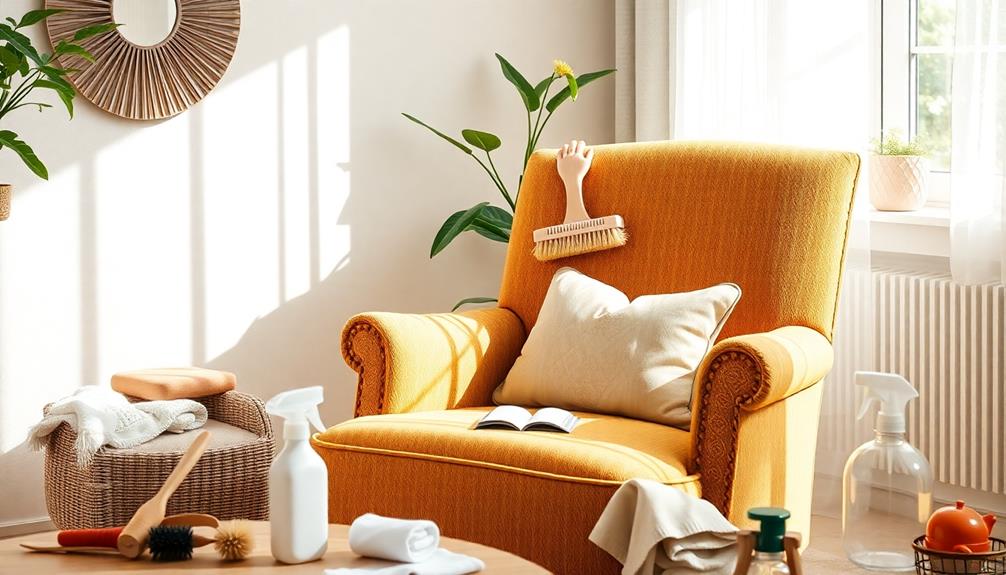
Maintaining the integrity of your furniture fabric requires a few simple yet effective care tips. By following these practices, you'll keep your upholstery looking fresh and new for longer.
- Check the care label: Always look for cleaning codes (W, S, WS, X) to determine the right cleaning method.
- Regular vacuuming: Use a vacuum cleaner with a soft bristle attachment at least once a month to remove dust, pet hair, and allergens.
- Spot cleaning: For stained areas, mix 2 cups distilled water, 1 tablespoon dish soap, and 1 tablespoon vinegar. Gently blot the stain with a microfiber cloth, ensuring you avoid rubbing it in.
You can also sprinkle baking soda on your fabric to absorb odors. Let it sit for at least 30 minutes before vacuuming to maintain freshness.
Additionally, don't forget to rotate and fluff cushions regularly. This helps prevent uneven wear and keeps your furniture comfy.
Always remember to conduct a spot test in an inconspicuous area before applying any cleaning solution, and follow the manufacturers' instructions for the best results.
With these tips, you'll easily clean your couch and keep it looking great!
Frequently Asked Questions
What Is the Best Way to Clean Sofa Fabric?
To clean your sofa fabric, always check the care tag first. For water-safe materials, use a gentle solution of water, dish soap, and vinegar. Regular vacuuming and baking soda can help maintain freshness and eliminate odors. For more stubborn stains, gently blot the area with a microfiber cloth, avoiding harsh scrubbing that could damage the fabric. If you’re unsure about how to clean a fabric sofa properly, always test any cleaning solution on an inconspicuous spot first. This ensures that the cleaner won’t cause discoloration or harm to the material.
What Is the Best Homemade Upholstery Cleaner?
For a great homemade upholstery cleaner, mix 2 cups distilled water, 1 tablespoon clear dish soap, and 1 tablespoon white vinegar in a spray bottle. Always spot test first to avoid damage or discoloration.
Can I Use Dawn Dish Soap to Clean My Fabric Couch?
Yes, you can use Dawn dish soap to clean your fabric couch. Just mix one tablespoon of soap with two cups of distilled water, test a hidden spot first, then gently blot the stained area.
How Do You Clean Old Fabric Furniture?
You might think old fabric furniture's beyond saving, but it's not! Start by vacuuming thoroughly, spot clean with a gentle solution, and test any cleaners first. You'll revive your furniture, bringing it back to life!
Conclusion
Now that you're armed with all these cleaning tips, it's hard to believe your furniture ever looked anything but pristine, right? Just imagine your once-stained couch, now a beacon of cleanliness, as you sit back and sip your coffee—carefully, of course. You've conquered the mess, and yet, it's almost as if your furniture's plotting its next spill. Remember, the battle of keeping it clean is ongoing, but with your newfound skills, you're definitely winning!
